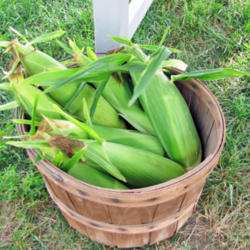
Corn's unique reproductive process has made it a plant breeder's dream. Ever since the theories of heredity put forth by such men as Gregor Mendel and Charles Darwin were recognized in the late 1800s, corn has been continually bred and recrossed to create new varieties.
Hybrid CornNew hybrids are developed as genetic discoveries are made, stimulated by gardeners' and farmers' more specialized needs. Field corn and popcorn varieties, as well as sweet corn, are hybridized because of the needs of commercial corn growers. In fact, for many years, most of the research in this area focused on large-scale corn production rather than on home gardens. Luckily, the needs of gardeners who have limited space and want maximum flavor and production are now being considered.
Seed catalogs now offer supersweet, extra-early, multicolored and multi-eared corn varieties. They also continue to offer fresh supplies of the dependable producers and the most popular varieties. Many of these varieties are hybrids, and they're often designated with the letter and number F1. This indicates the seed is the first-generation offspring of two different parent plants, and the parents have been selected to produce corn with certain characteristics. Many of the unusually colored varieties, however, are open-pollinated heirlooms that are gaining in popularity.
The qualities of sweetness, disease resistance or high productivity exist only in first-generation hybrid seed. Later generations revert to the traits of one of their original parent plants, which are usually inbred. The quality will probably be quite poor, which is why you may not be pleased with succeeding crops if you save and grow the seed of F1 hybrid corn.
Supersweet VarietiesSupersweet (sh2), sugar-enhanced (SE) and everlasting heritage (EH) varieties are becoming increasingly popular. They were developed after the discovery of the hereditary genes that control corn sweetness. These important genes are known as sugary1 and shrunken2. What they actually control is the plant's ability to change sugar into starch within the kernel. The sh2 (or supersweet) gene provides extra sweetness for longer periods than the SE (or sugar-enhanced) gene, but the sh2 varieties are a little more finicky about receiving the right growing conditions to produce a good crop.
By breeding and isolating certain varieties and characteristics, plant breeders have been able to produce hybrids that taste extra sweet. More important, many of these new varieties retain their sweetness for many days, both on the stalk and after harvesting. This is good news for market growers and for gardeners who want to enjoy their corn over a long time, rather than having to pick it all at once. On the downside, some gardeners feel that supersweet corn types are too sweet and don't have enough basic "corn" flavor.
This constant work with corn is the reason why you see new and different varieties offered every year by seed companies. It seems there is always another discovery just around the corner.
 Victory Seed Company has all the seeds you want for your best garden in 2024.
Victory Seed Company has all the seeds you want for your best garden in 2024.
For 25 years, the family-owned Victory Seed Company has provided the highest quality vegetable, herb and flower seeds to families across the country. We are passionate about providing you the best seeds available that give excellent germination, robust plants, and the harvest you want. With a catalog of over a thousand varieties, we have everything, and our prices are the kinds that we'd want to pay. We have hundreds of yesterday's heirloom vegetables, as well as today's award winning hybrid selections. Get to know us by visiting our website and browsing through our online vegetable seed catalog.
| 1. Planning Your Corn Crop |
| 2. Corn History and How it Grows |
| 3. Understanding Corn Genetics ← you're on this article right now |
| 4. Corn Growing: Getting Started |
| 5. How to Have the Earliest Corn |
| 6. Sweet Corn Essentials |
| 1. Planning Your Corn Crop |
| 2. Corn History and How it Grows |
| 3. Understanding Corn Genetics ← you're on this article right now |
| 4. Corn Growing: Getting Started |
| 5. How to Have the Earliest Corn |
| 6. Sweet Corn Essentials |